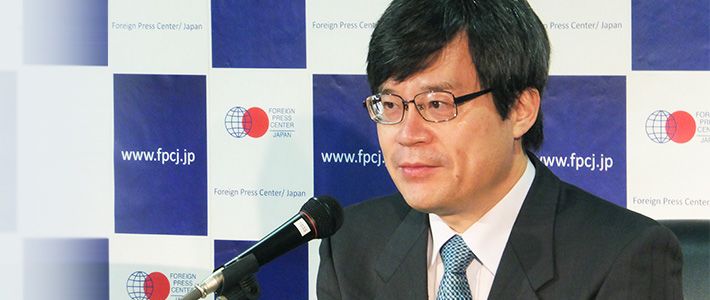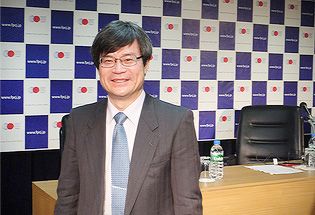
Nobel Laureate Amano Sees Bright Future for LEDs
Science Technology- English
- 日本語
- 简体字
- 繁體字
- Français
- Español
- العربية
- Русский
Professor Amano Hiroshi, one of the three winners of the 2014 Nobel Prize in Physics for the invention of efficient blue light-emitting diodes, spoke to a packed audience at the Foreign Press Center/Japan this month about the far-reaching potential of these LEDs. Amano sees a future where these devices are applied not only in lighting equipment but also in medical tools and other high-tech devices.
LED Lamps to Go Mainstream from 2016
Amano, a professor at Nagoya University, joined Professor Akasaki Isamu of Meijō University and Professor Nakamura Shūji of the University of California, Santa Barbara, in receiving the Nobel Prize in Physics from the Royal Swedish Academy of Sciences in December 2014.
When they produced bright blue light beams from their semiconductors in the early 1990s, the three physicists “triggered a fundamental transformation of lighting technology,” the academy said in its statement. “Red and green diodes had been around for a long time but without blue light, white lamps could not be created. Despite considerable efforts, both in the scientific community and in industry, the blue LED had remained a challenge for three decades.”
The statement hailed the three scientists’ achievement as revolutionary, saying that the twenty-first century “will be lit by LED lamps.”
In his FPC lecture Amano reminded the audience that the development of blue LEDs laid the groundwork for cellphones with full-color screens. He then referred to a recent private-sector survey that found that global sales of LED packages amounted to ¥1.6 billion in 2013 and are expected to more than double to ¥3.8 billion in 2020.
Amano predicts that as incandescent light bulb production is likely to come to a halt in many countries, LED lamps will become a mainstream source of lighting from 2016.
Need for Cheaper LEDs
On the energy benefits of LEDs, Amano said, “The US Department of Energy estimates that more than 70% of US lighting will be LED by 2030. The United States, which consumes about four times as much electricity as Japan, will see the use of LED lamps reduce power consumption by 300 terawatt-hours.” This figure matches the total electricity that would be produced by Japan’s 48 idle nuclear power reactors if they were active.
“In Japan,” he noted, “where LED lamps are more widespread than in the United States, 70% of lighting will be LED by 2020, leading to a reduction of about 7% in total power consumption.” This is equivalent to some ¥1 trillion in terms of electricity rates. But Amano added that in order to realize this scenario, there are problems to be resolved, such as making LED production five times cheaper by 2020.
Amano has previously noted that reducing production costs to one-fifth of their current level would induce a dramatic spread of LED lamps globally. In areas with no electricity, an LED lamp could be powered by batteries. This would enable people to read books or study at home, thereby helping to support education—and economic growth—in developing countries.
As part of efforts to reduce LED production costs, Amano referred to ongoing research into what he called “three-dimensional nanowire LEDs.” By using numerous ultrathin gallium nitride (GaN) wires in shapes with more exposed surfaces, manufacturers are aiming to increase the efficiency of light emission while using less material.
Other keys to reducing LED production costs include finding ways to use existing equipment to produce the newer substrates required by blue LEDs, as well as replacing sapphire substrates, which make 95% of existing LEDs, with GaN substrates, which can quadruple the brightness of LEDs. A Nagoya University team is involved in a research and development project with Aledia of France to develop the next generation of LEDs, and a joint undertaking with US and Swedish companies is also ongoing.
Tapping into Deep Ultraviolet Lighting
As well as applications for lighting and display apparatuses, Amano said that research is underway on use of LEDs in stimulating growth of crops at plant factories. The relatively new field of optogenetics is another area of focus for the tech.
Research is also being conducted into deep-ultraviolet LEDs with wavelengths as short as 250–350 nanometers. Deep-UV LEDs, which boast high efficiency and long life, have a wide range of potential applications, including treatment of skin diseases and DNA analysis, as well as sensors for water contamination to be used in areas where people need to purify drinking water. Amano noted that these could also be used for photochromic printing for 3D printers.
Amano revealed that the Nagoya University team has been stepping up preparation for the development of commercial products in these fields. But he also cautioned that the team is faced with severe competition from international rivals researching state-of-the-art technologies, such as GaN substrates.
An Image of Success
Amano advised researchers that the most important thing is to “keep an image of success” in their minds, looking forward to future commercialization. He recalled that by doing so, he had always succeeded in putting technologies to practical use.
When asked by Nippon.com about his own future, Amano responded: “If we succeed here, I have other visions for changing the world. As I firmly believe I can achieve them, I want to get them all done in the eleven years before I reach retirement age.”
(Originally written in Japanese by Harada Kazuyoshi, Nippon.com, and published on January 15, 2015. Photographs by Harada Kazuyoshi. Banner photo: Professor Amano Hiroshi speaking at the Foreign Press Center/Japan, Tokyo, on January 14, 2015.)
